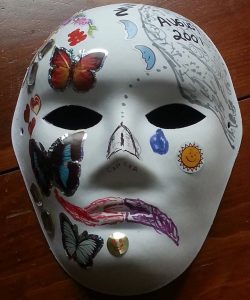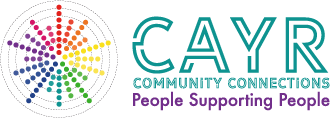So June is brain injury awareness month here in Canada, a time to recognize and try to understand the complications that brain injury can bring into one’s life.
 A movement titled #unmaskingbraininjury that my mom took part of. This is her mask and her feelings; loneliness, emptiness, depression, hurt, but also happiness, love, and the joy of being alive. Many others tok part and created their masks to reveal very deep and profound feelings.
A movement titled #unmaskingbraininjury that my mom took part of. This is her mask and her feelings; loneliness, emptiness, depression, hurt, but also happiness, love, and the joy of being alive. Many others tok part and created their masks to reveal very deep and profound feelings.
Did you know? (According to Brain Injury Canada https://www.braininjurycanada.ca/ )
- Brain injury is the NUMBER ONE cause of death and disability WORLDWIDE among children, youth and those under age 44.
- Over two million Canadians live with the effects of an acquired brain injury
Individuals can acquire a brain injury in quite a few different ways that can happen either externally or internally; and it affects people in varying ways as well. As individuals we are all unique, and our bodies can react to a head trauma similarly or in contrast to others.
An injury can be acquired by means of car accident or any type of blow to the head, or it can occur as a result of heart attack, stroke, or aneurysm. Less common and quite rare, ABI can be sustained through viral infection. And much like HIV, the immune system (after brain injury) can be affected in one’s body and can cause havoc in differing ways. However, ABI begins with trauma to the head causing cognitive and neurological complications that can persist its way to the immune system; but not in every case. The opposite is true of HIV where an individual’s immune system is attacked and neurological complications may result from damage caused by the virus.
Following brain injury, a person may also have difficulties with mental health issues, making decisions or predicting consequences, therefore putting people at a greater risk of other injuries, HIV, or substance misuse.
ABI is not necessarily a physical thing, even as a result of a car accident where broken bones can heal, and therefore it is considered an invisible disability. And much like other hidden trauma’s that can overwhelm people’s lives, such as mental health or HIV, the concealed nature of this disability can present difficulties and challenges on top of the affects the injury causes an individual.
Discrimination, misunderstandings, wrongful assumptions, and stigma can enter into things. These unfair treatments are the reason behind the promotion of awareness, and we need to work together and understand one another to truly break through these things; to break barriers; and to overcome the silos.
By Mark Koning
Mark is the Communications & Administration Specialist with the AIDS Committee of York Region. Mark is also an Author and Blogger of Challenging Barriers and The BIST Blog. (Brain Injury Society of Toronto)





